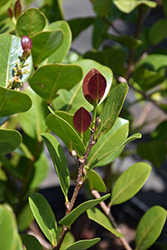It's all about ...
plants

Height: 20 feet
Spread: 15 feet
Sunlight:
![]()
![]()
Hardiness Zone: 10a
Other Names: Paradise Plum, Icaco
Description:
A creeping shrub near the sea, or bushy small tree inland; nearly-round foliage emerges chartreuse or red tinged and matures to green; inconspicuous flower clusters in spring, followed by mildly sweet, edible purple fruit; great for cooking or preserves
Ornamental Features
Cocoplum is primarily grown for its highly ornamental fruit. The fruits are showy deep purple drupes which fade to black over time, which are carried in abundance from late spring to late summer. The fruit can be messy if allowed to drop on the lawn or walkways, and may require occasional clean-up. It has attractive dark green foliage with grayish green undersides and tinges of chartreuse which emerges brick red in spring. The glossy oval leaves are highly ornamental and remain dark green throughout the winter. The brown bark and coppery-bronze branches add an interesting dimension to the landscape.
This plant is primarily grown as an ornamental, but it's also valued for its edible qualities. The oval mild fruit is most often used in the following ways:
- Fresh Eating
- Cooking
- Preserves
- Canning
Landscape Attributes
Cocoplum is a multi-stemmed evergreen shrub with an upright spreading habit of growth. Its average texture blends into the landscape, but can be balanced by one or two finer or coarser trees or shrubs for an effective composition.
This shrub will require occasional maintenance and upkeep, and can be pruned at anytime. It is a good choice for attracting birds, butterflies and squirrels to your yard. Gardeners should be aware of the following characteristic(s) that may warrant special consideration;
- Spreading
- Self-Seeding
Cocoplum is recommended for the following landscape applications;
- Mass Planting
- Hedges/Screening
- General Garden Use
- Naturalizing And Woodland Gardens
Planting & Growing
Cocoplum will grow to be about 20 feet tall at maturity, with a spread of 15 feet. It has a low canopy with a typical clearance of 2 feet from the ground, and is suitable for planting under power lines. It grows at a slow rate, and under ideal conditions can be expected to live for approximately 30 years. This is a self-pollinating variety, so it doesn't require a second plant nearby to set fruit.
This shrub does best in full sun to partial shade. It is very adaptable to both dry and moist growing conditions, but will not tolerate any standing water. It is considered to be drought-tolerant, and thus makes an ideal choice for xeriscaping or the moisture-conserving landscape. This plant should not require much in the way of fertilizing once established, although it may appreciate a shot of general-purpose fertilizer from time to time early in the growing season. It is not particular as to soil type or pH, and is able to handle environmental salt. It is somewhat tolerant of urban pollution. This species is native to parts of North America..
This plant is not reliably hardy in our region, and certain restrictions may apply; contact the store for more information.
